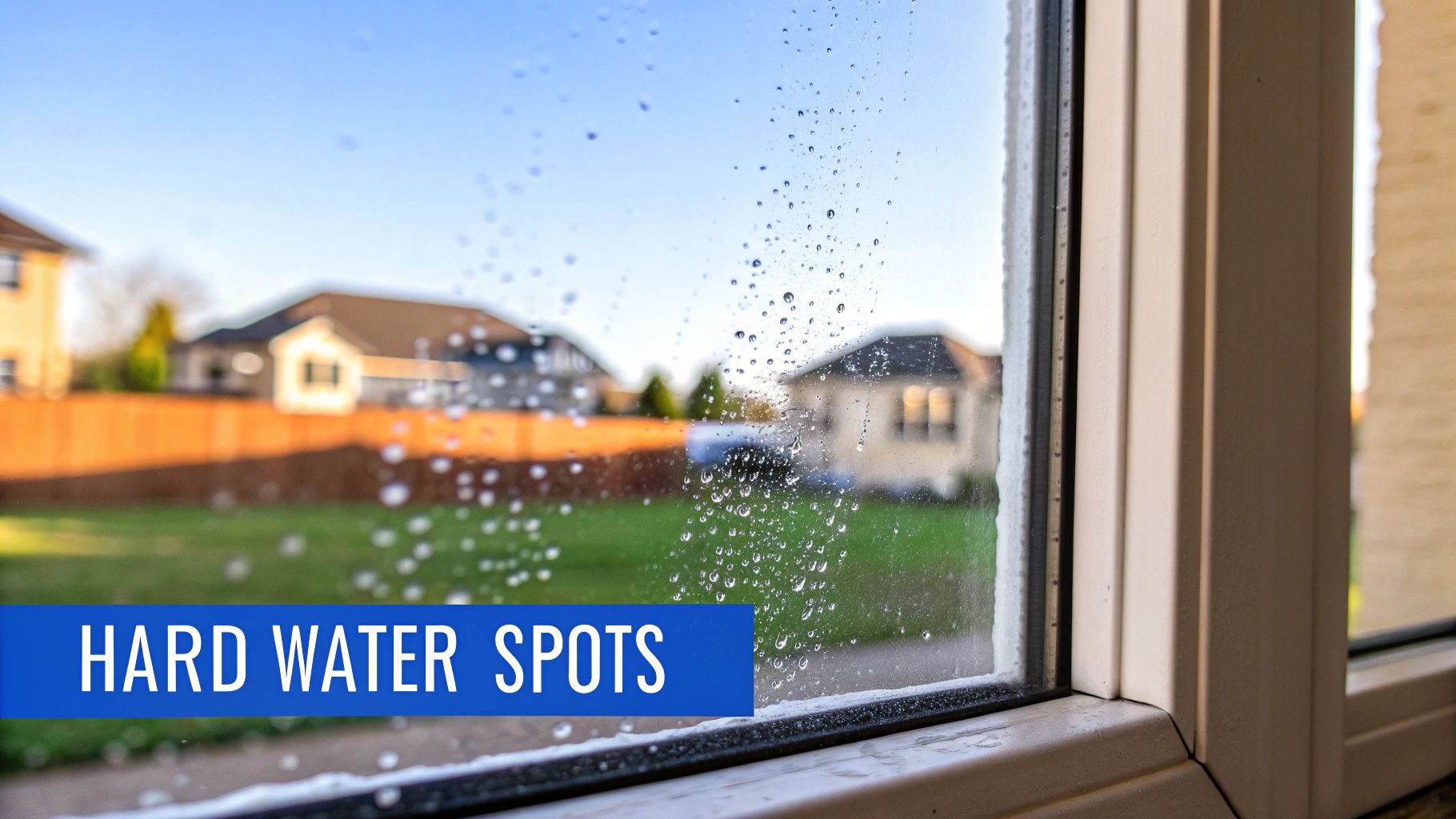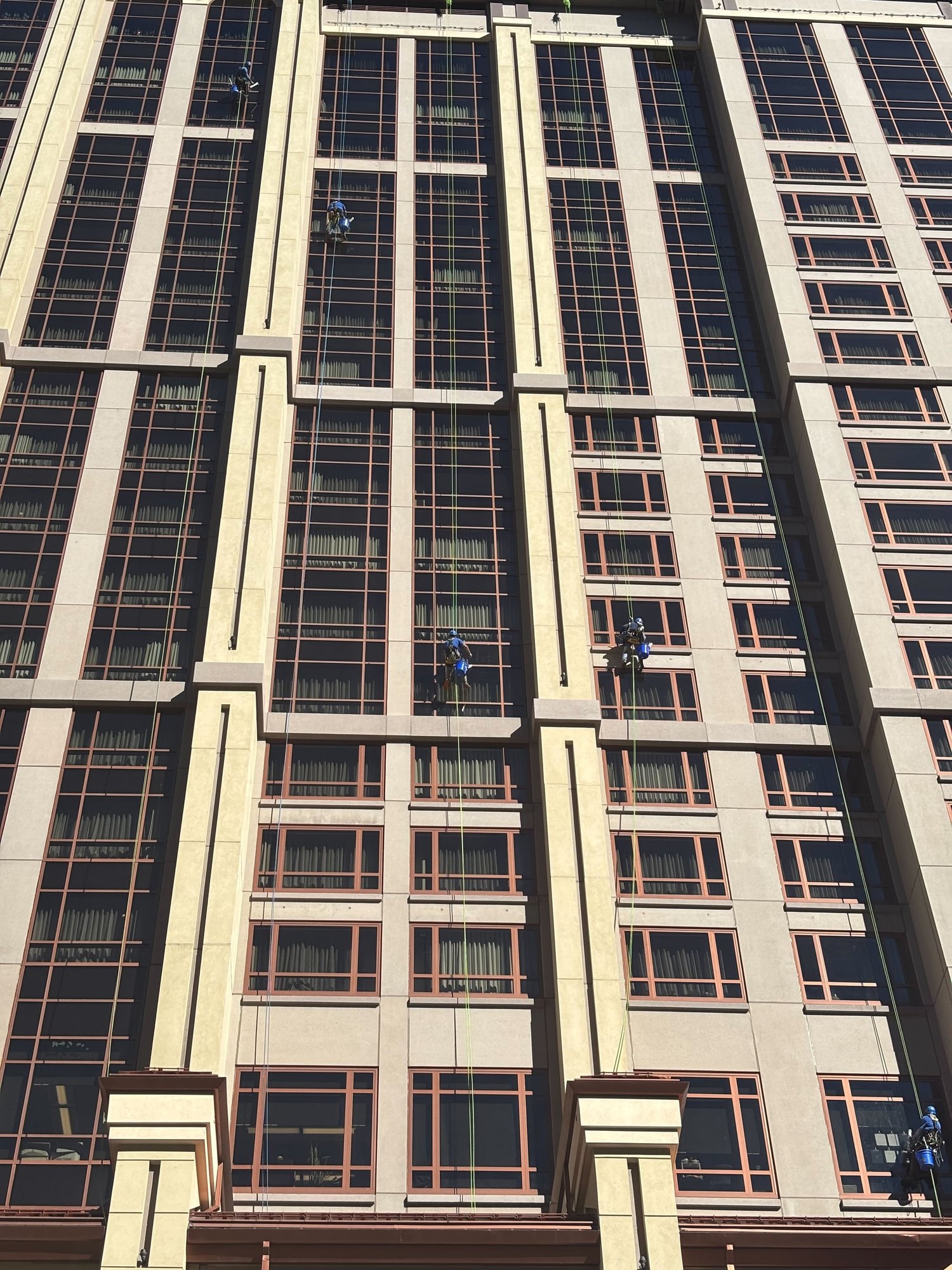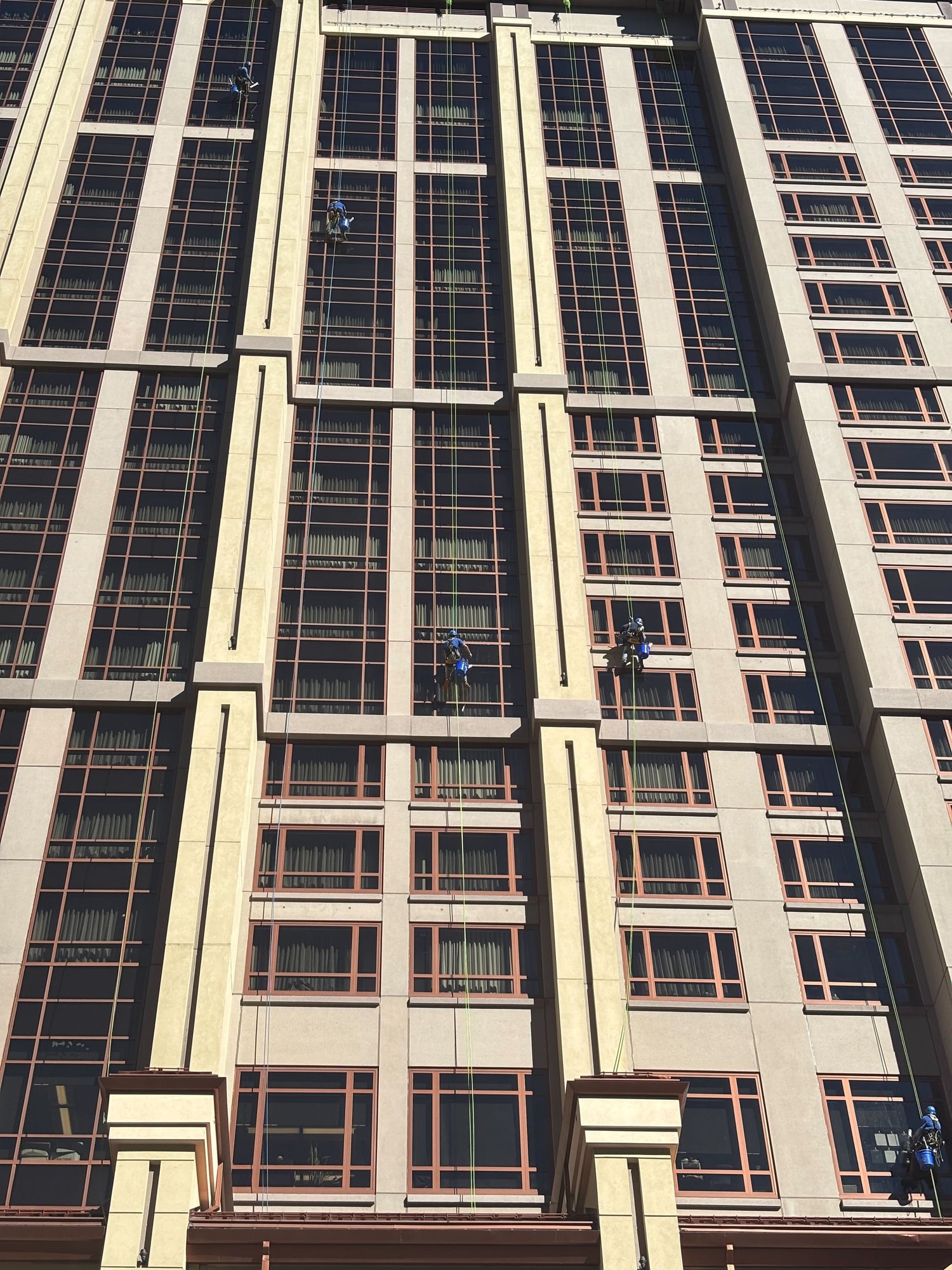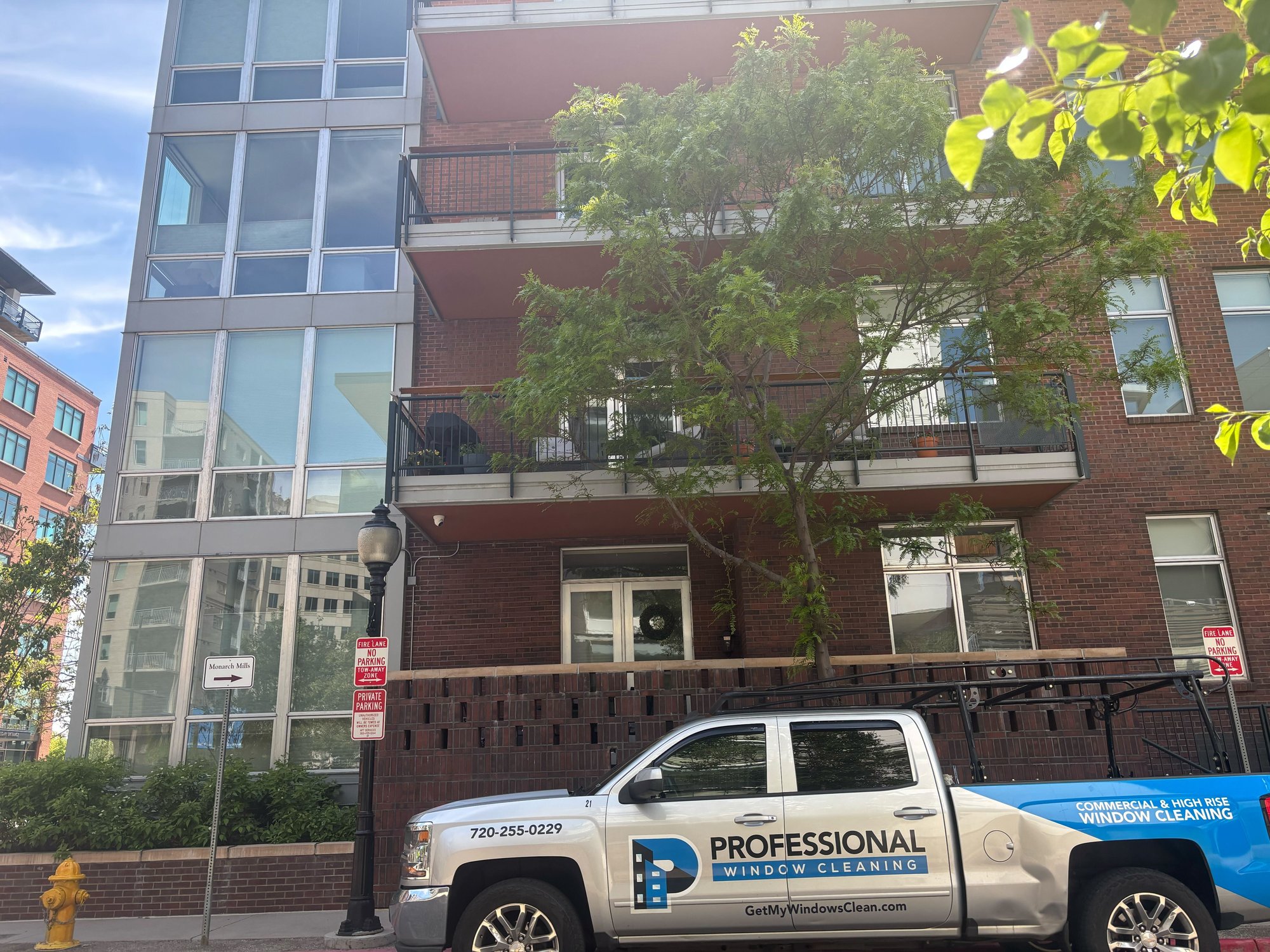Removing Hard Water Spots on Windows Like a Pro

Those chalky, stubborn spots on your windows aren't just dirt. They’re mineral deposits, mainly calcium and magnesium, left behind when water evaporates. You’re not just cleaning grime—you're tackling a chemical residue that has literally bonded to the glass.
Why Hard Water Leaves Those Annoying Stains on Glass

Think of those frustrating white spots as the ghosts of evaporated water droplets. When a drop of water dries on your window, everything dissolved in it stays put. If the water is "hard," it’s loaded with minerals, creating those signature milky stains that ruin your view.
This is a far more common problem than most people think. Globally, about 85% of water sources have some level of hardness. In places that rely on groundwater filtered through limestone, that number can jump past 90%. Glass is also porous, so over time, these minerals can seep in and cause permanent damage. If you want to get into the nitty-gritty, this overview of water spot removal on fishwindowcleaning.com offers a great deep dive.
The Usual Suspects Behind Mineral Buildup
The sources of these stubborn spots are often part of our daily routines, especially in drier climates. If you live somewhere like Phoenix or Las Vegas, you're probably all too familiar with this battle thanks to the local water supply.
Here are the most common culprits I see on the job:
- Sprinkler Overspray: This is the big one. Your landscaping sprinklers repeatedly douse the windows, and the sun bakes those minerals right onto the glass.
- Hose Rinsing: Giving your windows or siding a quick rinse with a garden hose is a guaranteed way to get spots. You're just leaving untreated hard water to air-dry.
- Rainwater Runoff: Believe it or not, even rain can be a problem. As it runs down building materials like concrete, brick, or stucco, it picks up minerals before splashing onto your windows.
Key Takeaway: Hard water spots aren't just surface grime. They are mineral deposits that can bond with and even etch into the glass if left untreated, leading to permanent cloudiness and corrosion. This is why quick and proper cleaning is so essential for keeping your windows clear.
Your Toolkit for Spotless Windows
Getting hard water spots off your windows means you need the right gear in your corner. Before you reach for just any old cleaner, it's crucial to match your tools to just how bad the stains are. For those minor, fresh spots, you'd be surprised how effective (and safe) simple household items can be.
But when you’re up against those stubborn, baked-on mineral deposits that have been sitting there for months? That’s when you need to bring in the heavy hitters. We pros rely on specific gear designed to dissolve those minerals without messing up your glass. The real goal is to break down the calcium and magnesium—not just scrub them into oblivion, which is a surefire way to get scratches.
Choosing Your Cleaning Solution
The big question is usually whether to go with a DIY mix or a commercial-grade product. Honestly, it all comes down to how long those spots have been there. A simple blend of distilled white vinegar and water can work wonders on new spots, but older, more established stains demand a much stronger approach.
If you're curious about what the pros keep in their vans for all sorts of tough jobs, take a look at our complete guide on professional window cleaning tools.
DIY vs. Commercial Hard Water Spot Removers
To help you figure out what’s best for your situation, here's a quick comparison of the most common solutions. Think about the age and severity of your spots before you decide.
Ultimately, the right choice depends on the battle you're fighting. Fresh spots are an easy win for vinegar, but for those deeply etched, sun-baked stains, a commercial remover is going to save you a lot of time and frustration.
Pro Tip: For the really tough customers, we sometimes break out the #0000 grade steel wool. It's incredibly fine, and as long as you use it with plenty of lubrication (like your cleaning solution), it can gently lift mineral deposits without scratching the glass. But please, always test it on a small, hidden corner first just to be safe.
Pro Methods for Removing Hard Water Stains
When your DIY solutions just aren't cutting it, it’s time to bring in the heavy hitters. Professional window cleaners use only two methods for getting rid of those stubborn hard water spots on windows: the classic squeegee technique and the modern pure-water system. Each has its time and place, depending on just how bad the stains are and what kind of window you're dealing with.
This simple infographic breaks down the core tools you'd start with for a more traditional approach.

As you can see, even the pros often start with the basics before moving on to more advanced methods for tougher jobs.
Mastering the Squeegee Technique
The traditional squeegee method is an art form. When it's done right, you're guaranteed a perfect, streak-free shine. But it's about more than just dragging a piece of rubber across the glass; it takes precision and the right cleaning solution to really break down those mineral deposits.
First things first, you need to apply your cleaning solution generously. Make sure the entire surface is wet. For really tough mineral buildup, this might mean using a professional-grade acidic cleaner. Then, using deliberate, overlapping strokes, pull the squeegee straight down from top to bottom. The key is to wipe the blade with a clean microfiber towel after every single pass. This little step is crucial—it stops you from just dragging the dissolved minerals right back onto the window.
If you want to round out your technique, learning how to achieve a perfect streak-free finish will make all the difference.
The Power of Pure Water Systems
For a more modern take, especially on exterior glass, professionals are all about pure-water systems. These setups use a heavy-duty filtration process, like reverse osmosis or deionization, to strip 100% of dissolved minerals from the water. What you're left with is "pure" water, and it's an incredibly powerful cleaning agent on its own.
Because it contains no minerals, pure water is highly reactive and acts like a magnet. When it hits the window, it aggressively pulls existing minerals from the glass, dissolving them on contact. The best part? It dries completely spot-free, eliminating the need for a squeegee altogether.
This method is a game-changer for multi-story buildings where getting up on a ladder with a squeegee would be both inefficient and dangerous. It's the go-to for pros working on commercial properties, especially in areas where hard water is a known problem.
But what happens when the stains have been there for years? Sometimes, all that mineral buildup can cause permanent etching, where the minerals have literally corroded the glass surface. In these severe cases, no amount of cleaning will restore the window's clarity. This is where you'd need professional glass polishing services to carefully grind down and buff the glass back to its original state—a delicate task definitely best left to trained technicians.
Keeping Your Windows Clear for Good

After putting in all that effort to remove those stubborn stains, the last thing you want is for them to reappear. Preventing hard water spots on windows is all about being proactive and a little bit smart with your maintenance. Trust me, a few simple adjustments now can save you a world of scrubbing later on.
The biggest culprit is often the most obvious: water sources hitting your glass. You’d be surprised how many times the problem is just a poorly aimed sprinkler head that’s been dousing a window all season long. Fixing that alone can make a massive difference.
Building a Defensive Barrier
One of the best long-term moves you can make is applying a hydrophobic glass sealant. This invisible coating creates a slick surface that water just can’t cling to. Instead of sitting there and evaporating—leaving its mineral baggage behind—the water beads up and rolls right off.
Think of it like waxing your car. It’s a protective shield that not only prevents buildup but makes future cleaning a breeze. For more tips on keeping that gleam, check out our guide on how to get streak-free windows.
Another powerful strategy is just getting into a simple maintenance rhythm. It doesn't have to be complicated.
- Redirect Your Sprinklers: This is the big one. Make sure your irrigation is watering the garden, not the glass. It’s a five-minute fix that can slash spot formation.
- Do a Quick Dry-Down: If your windows get wet from hosing down the siding or a big rainstorm, just give them a quick pass with a squeegee. No water, no spots.
- Clean Regularly: A light, routine cleaning prevents minerals from ever getting a chance to bond with the glass in the first place.
Taking preventative steps isn’t just about saving your sanity—it saves real money. Routine rinsing and drying can reduce the recurrence of spots by up to 60%, while simply adjusting sprinklers can cut buildup by 20-30%. When you consider that hard water damage leads to an estimated $1.2 billion in annual window replacement costs in the U.S., a little prevention goes a long way.
If you’re ready to tackle the issue at its root, looking into home plumbing solutions for hard water like a water softener can be a game-changer for your entire property.
When to Hand the Job to a Professional
Sometimes, even the most determined DIY effort just won't cut it, especially when you're up against severe hard water spots on windows. If stains have been baking in the sun for months or even years, the minerals can cause permanent damage that home remedies simply can’t reverse.
This is particularly true when you’re dealing with etching. This is the point where minerals have physically corroded the glass surface, leaving it permanently cloudy and feeling rough to the touch. No amount of scrubbing with vinegar or store-bought cleaners will restore its clarity. If you've reached this stage, it's a clear signal that you need a professional.
Safety and Specialized Equipment
Another huge factor is safety. Let's be honest, cleaning hard-to-reach second-story windows or massive commercial panes without the proper equipment is a serious risk. It's not a job for a wobbly ladder and a bucket.
Professionals show up with the right gear, from industrial-grade ladders and safety harnesses to advanced cleaning systems that make the job both safe and incredibly effective.
Professionals have only two methods in their arsenal for these tough jobs: the use of a squeegee, or the use of a pure-water system. These systems use deionized water that literally acts like a magnet, pulling mineral deposits right off the glass for a perfect, spot-free shine without any harsh chemicals.
For homeowners in cities known for hard water, like Denver, calling a pro isn't about convenience—it's about getting a result that DIY methods can't deliver while protecting your glass from getting worse. They have the experience and the right tools to restore your windows safely and make them gleam again.
Got Questions About Hard Water Stains?
When you’re dealing with stubborn hard water spots on windows, a lot of questions come up. We hear them all the time from homeowners trying to get their glass back to its original shine. Getting clear, straightforward answers is the first step to picking the right method and keeping your glass safe.
Can Hard Water Spots Permanently Damage My Windows?
Yes, unfortunately, they absolutely can. When mineral deposits from hard water sit on glass for too long, they start to etch into the surface itself. It's a process of corrosion that creates a cloudy, rough texture that no amount of regular cleaning will fix.
This is exactly why you want to tackle hard water spots sooner rather than later. What starts as a simple cleaning job can quickly escalate into a permanent problem, potentially requiring professional glass polishing or even a full window replacement if it's ignored.
Will Vinegar and Steel Wool Scratch My Glass?
This is a great question and a totally valid concern. The good news is that distilled white vinegar, while acidic enough to break down minerals, is generally safe for glass.
The real trick is the steel wool. You can’t just grab any kind; it has to be #0000 grade steel wool, which is incredibly fine. The key is to always use it on a wet surface with plenty of your cleaning solution to act as a lubricant. And before you go all in, test it on a small, out-of-the-way spot first just to be safe.
Isn't Bottled Water the Same as Pure Water for Cleaning?
Not at all—they're worlds apart. Bottled drinking water might be filtered, but it's intentionally left with minerals to give it taste. If you use it to clean your windows, you’re just putting more minerals back on the glass, which will leave spots all over again.
Professional pure-water systems, on the other hand, use a process like deionization or reverse osmosis. This strips out virtually all the total dissolved solids (TDS), creating mineral-free water. This "pure" water is amazing for cleaning because it naturally pulls deposits off the glass and dries completely spot-free. It’s one of the two main methods the pros use, the other being a traditional squeegee.
How Often Should I Reapply a Glass Sealant?
How long a hydrophobic glass sealant lasts really depends on the product you use and the weather in your area. As a general rule of thumb, to get the best protection against future hard water buildup, you should plan on reapplying a quality sealant every three to six months.
When you've tried the DIY tricks and those tough hard water stains just won't budge, it's time to call in the experts. Professional Window Cleaning has the right tools and deep experience to restore your view safely and effectively. Get a free estimate today and see the difference a professional clean can make!
Related articles
Read our blog posts regularly and keep learning.




